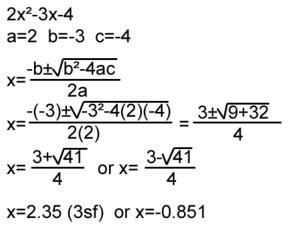This week, we learned how to solve quadratic equations by factoring, completing the square, and using the quadratic formula.
Factoring
Factoring and using the zero product property is one of the easiest ways to solve a quadratic formula, and it works with rational roots.
- A quadratic equation is any equation that can be written in the form a
+ bx + c= 0.
- Zero product property: if ab=0, then a=0 and b=0, or both a, b=0
example:
3 – 21x- 54= 0
- Factor, remembering CDPEU
3( – 7x- 18)= 0
- Use the zero product property
(x+2) (x-9)= 0
Either x+2= 0 or x-9= 0
x= -2, x= 9
Completing the Square
When the equation doesn’t factor, completing the square is a great way to solve the quadratic equation, and it works well with irrational roots.
- Rearrange the equation if the coefficient of
is negative
- Make sure to get rid of the coefficient of
by dividing each side by the coefficient (when the equation equals to 0)
- Move the constant term to the right of the equation
- complete the perfect square by dividing the 2nd term and multiplying and squaring it, and adding it to both sides of the equation
- factor the perfect square, and simplify the right side
- rake the square root of each side, and isolate the x
example:
12x= -2 + 54
2 + 12x= 54
+ 6x= 27
+ 6x + 9= 27+ 9
√ =
√36
x-3= 6
x= 3 6
Quadratic Formula
The Quadratic formula is easy to use if it is arranged in the right form.
- Quadratic formula:

- Identify the values of a,b, and c( the coefficients) a
+ bx+ c= 0
- Plug a,b, and c in the formula and solve the equation
example:
